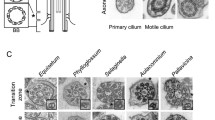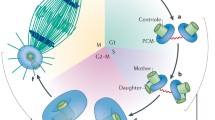Abstract
In mammals, three calmodulin (CaM) genes code for 100% identical proteins. In these species, four centrin (Cetn) genes have been reported to exist. They are examined in this paper. While the gene for Cetn 1 contains no introns and appears to be derived from Cetn 2 by retroposition, a gene product for Cetn 1 is expressed. Cetn 2, 3, and 4 represent bona fide genes. The major difference between the members of the CaM and the Cetn subfamilies is the presence (usually) in Cetn of an approximately 23 amino acids long (but occasionally much longer) protruding amino acid end. In all members of these two subgroups, four EF hand motifs (in this paper taken as loops containing 12 amino acids) are separated by 24, 25 and 24 amino acids (each a helix–loop–helix) positioned between motifs 1and 2, 2 and 3, and 3 and 4, respectively. This rule applies not only to CaM and Cetn in mammals but also to these two subfamilies in simpler eukaryotes such as Saccharomyces cerevisiae and Giardia lamblia. The various mRNA products can be identified most readily by their characteristic 3′ UTRs. While CaM is an ancient molecule that is expressed in all cells and is ubiquitous within these cells and interacts therein with almost 100 different proteins, many of which display the IQ or related binding motifs, the distribution and function of Cetn (an equally ancient molecule) is restricted mostly to basal bodies (e.g. in rods of the retina), axonemes, flagella, cilia and centrosomes. Are these two subclasses of calcium carriers (each molecule possessing four EF hands which possibly interact with different association constants)—if they are both present within a cell—randomly chosen for their service to the specific proteins with which they interact?


Similar content being viewed by others
References
Gilbert W (1987) The exon theory of genes. Cold Spring Harbor Symp Quant Biol 52:901–905
Friedberg F, Rhoads AR (2001) Evolutionary aspects of calmodulin. IUBMB Life 51:215–221
Strynadka NC, James MN (1989) Crystal structure of the helix–loop–helix calcium-binding proteins. Annu Rev Biochem 58:591–998
Tourbez M, Firanescu C, Yang A et al (2004) Calcium-dependent self-assembly of human centrin 2. J Biol Chem 278:47672–47680
Hart PE, Glantz JN ,Orth JD et al (1999) Testis-specific murine centrin, Cetn1. Genomics 60:1l0–120
Moncrief ND, Kretsinger RH, Goodman M (1990) Evolution of EF-hand calcium modulated proteins. J Mol Evol 30:522–562
Hart PE, Poynter GM, Whitehead CM et al (2001) Characterization of the X-linked murine centrin Cetn2 gene. Gene 264:205–213
Gavet O, Alvarez C, Gaspar P et al (2003) Centin4p, a novel mammalian centrin specifically expressed in ciliated cells. Mol BioI Cell 14:1818–1834
Correa G, Morgado-Diaz JA, Benchimol M (2004) Centrin in Giardia lamblia—ultrastructural localization. FEMS Microbiol Lett 233:91–96
Araki M, Matsutani C, Takemura M et al (2001) Centrosome protein centrin 2/caltractin 1 is part of the xermoderma pigmentosum group c complex. J Biol Chem 276:18665–18672
Rhoads AR, Friedberg F (1997) Sequence motifs for calmodulin recognition. FASEB J 11:331–340
Popescu A, Miron S,BlouquitY et al (2003) Xeroderma pigmentosum group c protein possess a high affinity binding site to human centrin 2 and calmodulin. J BioI Chem 278:40252–40261
Giessl A, Pulvermuller A, Trojan P et al (2004) Differential expression and interaction with the visual G-protein transducin of centrin isoforms. J Biol Chem 279:51472–51481
Otto EA, Loeys B, Khanna et al (2005) Nephrocystin-5, a ciliary IQ domain protein. Nat Genet 37:282–288
Do Carmo Avides M, Glover DM (1999) Abnormal spindle protein, Asp. Science 283:17733–17736
Nishimura T, Takahashi M, Kim H-S et al (2005) Centrosome-targeting region of CG-NAP causes centrosome amplication. Genes to Cells 10:75–86
Author information
Authors and Affiliations
Corresponding author
Rights and permissions
About this article
Cite this article
Friedberg, F. Centrin isoforms in mammals. Relation to calmodulin. Mol Biol Rep 33, 243–252 (2006). https://doi.org/10.1007/s11033-006-9004-z
Received:
Accepted:
Published:
Issue Date:
DOI: https://doi.org/10.1007/s11033-006-9004-z




